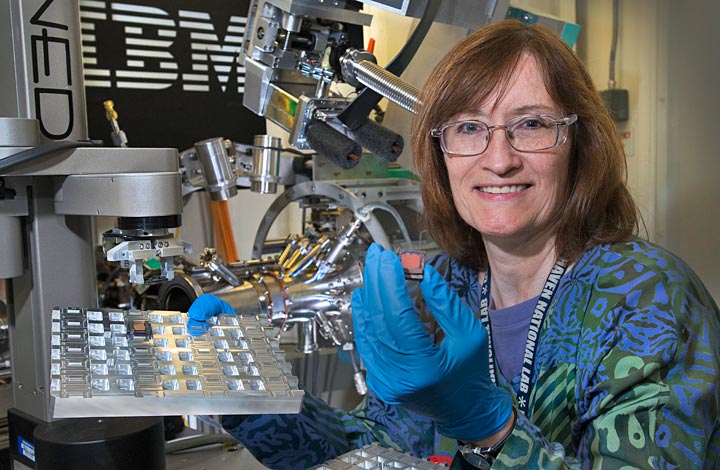User Profiles at NSLS: Jean Jordan-Sweet, IBM
May 27, 2014
This is part of a series of profiles on users at the National Synchrotron Light Source (NSLS). First operated in 1982, NSLS has accommodated more than 18,400 unique users in its lifetime as a Department of Energy user facility (see NSLS user stats). After 32 years of distinguished operations, NSLS will shut down on September 30, 2014. Replacing it is NSLS-II, which has been under construction since 2009 and is on track for early completion. When fully built out, NSLS-II will accommodate 60-70 beamlines and host over 4,000 users every year.
Why do you use NSLS?
IBM has been in several PRTs [participating research teams], from the beginning of operations 32 years ago until the facility closes at the end of September this year. The x-ray lithography effort on U6 and U2 enabled IBM to demonstrate the feasibility of proximity lithography using 1 nanometer soft x-rays and transfer that technology to a compact synchrotron at one of our manufacturing sites. At the same time, IBM built three beamlines at U8 for photoemission spectroscopy and soft x-ray optics research.
A beamline and high-resolution display analyzer were moved from the light source in Wisconsin to U8 because the NSLS VUV ring had about 1,000 times more flux. I started as a post-doc on U8 in 1984, about a year after IBM built a new beamline for the analyzer, which delivered a much wider energy range of photons and had very good resolution. Then, when IBM worked in collaboration with MIT to build the x-ray diffraction beamlines at X20, I got a permanent job with IBM to run those beamlines. They were originally designed for doing condensed matter physics research, but have evolved into instrumentation for studying materials and processes for microelectronics technologies. IBMers call them “our synchrotron tools.” They’ve been going strong and will be used right up to the end of NSLS operations.
IBM has been a beneficiary of the PRT system. It has been very important for us to have control over our instrumentation development and scheduling, plus have a lot of beamtime for the wide range of work we do here. I feel that the NSLS and the synchrotron community have also benefitted greatly from the contributions IBM has made in unique instrumentation, technique development and scientific output.
What will you do when NSLS shuts down?
We’ll have to split our programs up for a few years until we have a home at NSLS-II. We’re commissioning a new fully -automated end station for in-situ rapid thermal annealing measurements that will be shipped to the Canadian Light Source and be run remotely by IBMers, our collaborators, and general users. Our other programs, mainly using XRD techniques for studying strain and texture in thin films and nanostructures, will have to be done through general user proposal systems at other synchrotrons.
Do you plan to use NSLS-II? Why?
Yes. We submitted a proposal for the MPP [Materials Physics and Processing] NxtGen beamline and planned to directly transfer our programs from the NSLS. But we were disappointed when NxtGen beamline construction got postponed, and we won’t have a beamline at the new facility until at least 2017. We plan to submit a partner user proposal for MPP and install a second automated rapid thermal annealing endstation in one hutch and a standard diffraction endstation in the other. Not only will NSLS-II provide higher brightness for our measurements, but it also is close enough to the T.J. Watson Research Center in Yorktown Heights that I consider it a regional facility for us, as the NSLS has been.
User facilities like the NSLS – and down the road NSLS-II – are unique extensions of the research tools we have at IBM. Also, because IBM does more applied work, we like to collaborate with many people from other institutions who get down to fundamental materials studies.
The return on IBM’s investment has been so valuable. This has been a great example of government-industry cooperation: we provide the beamlines and the government provides the photons!
2014-4927 | INT/EXT | Newsroom










